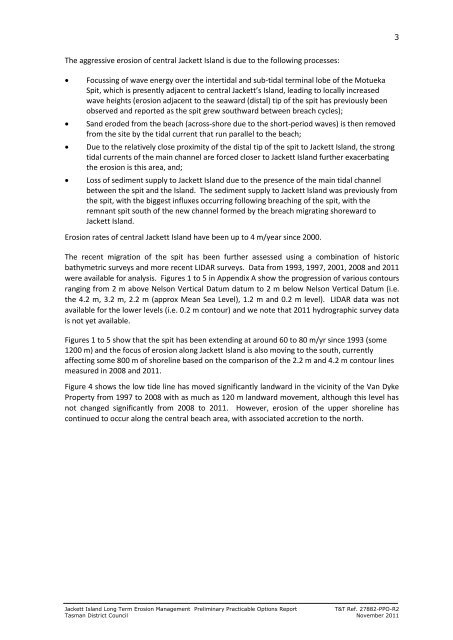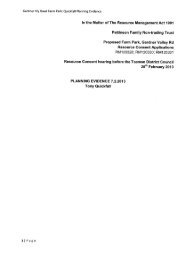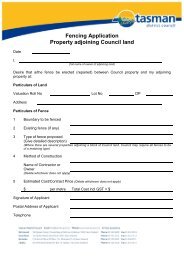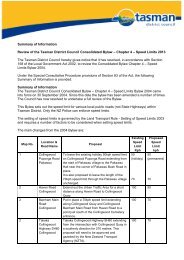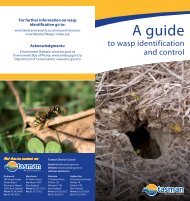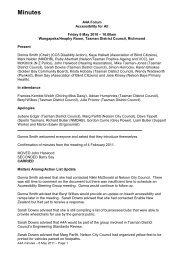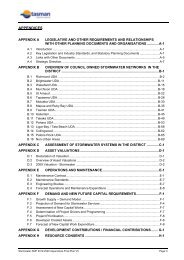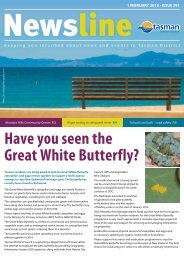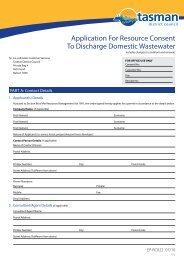RESC11-12-02 Port Motueka Groyne-Jackett Island Erosion ...
RESC11-12-02 Port Motueka Groyne-Jackett Island Erosion ...
RESC11-12-02 Port Motueka Groyne-Jackett Island Erosion ...
You also want an ePaper? Increase the reach of your titles
YUMPU automatically turns print PDFs into web optimized ePapers that Google loves.
3<br />
The aggressive erosion of central <strong>Jackett</strong> <strong>Island</strong> is due to the following processes:<br />
<br />
<br />
<br />
<br />
Focussing of wave energy over the intertidal and sub-tidal terminal lobe of the <strong>Motueka</strong><br />
Spit, which is presently adjacent to central <strong>Jackett</strong>’s <strong>Island</strong>, leading to locally increased<br />
wave heights (erosion adjacent to the seaward (distal) tip of the spit has previously been<br />
observed and reported as the spit grew southward between breach cycles);<br />
Sand eroded from the beach (across-shore due to the short-period waves) is then removed<br />
from the site by the tidal current that run parallel to the beach;<br />
Due to the relatively close proximity of the distal tip of the spit to <strong>Jackett</strong> <strong>Island</strong>, the strong<br />
tidal currents of the main channel are forced closer to <strong>Jackett</strong> <strong>Island</strong> further exacerbating<br />
the erosion is this area, and;<br />
Loss of sediment supply to <strong>Jackett</strong> <strong>Island</strong> due to the presence of the main tidal channel<br />
between the spit and the <strong>Island</strong>. The sediment supply to <strong>Jackett</strong> <strong>Island</strong> was previously from<br />
the spit, with the biggest influxes occurring following breaching of the spit, with the<br />
remnant spit south of the new channel formed by the breach migrating shoreward to<br />
<strong>Jackett</strong> <strong>Island</strong>.<br />
<strong>Erosion</strong> rates of central <strong>Jackett</strong> <strong>Island</strong> have been up to 4 m/year since 2000.<br />
The recent migration of the spit has been further assessed using a combination of historic<br />
bathymetric surveys and more recent LIDAR surveys. Data from 1993, 1997, 2001, 2008 and 2011<br />
were available for analysis. Figures 1 to 5 in Appendix A show the progression of various contours<br />
ranging from 2 m above Nelson Vertical Datum datum to 2 m below Nelson Vertical Datum (i.e.<br />
the 4.2 m, 3.2 m, 2.2 m (approx Mean Sea Level), 1.2 m and 0.2 m level). LIDAR data was not<br />
available for the lower levels (i.e. 0.2 m contour) and we note that 2011 hydrographic survey data<br />
is not yet available.<br />
Figures 1 to 5 show that the spit has been extending at around 60 to 80 m/yr since 1993 (some<br />
<strong>12</strong>00 m) and the focus of erosion along <strong>Jackett</strong> <strong>Island</strong> is also moving to the south, currently<br />
affecting some 800 m of shoreline based on the comparison of the 2.2 m and 4.2 m contour lines<br />
measured in 2008 and 2011.<br />
Figure 4 shows the low tide line has moved significantly landward in the vicinity of the Van Dyke<br />
Property from 1997 to 2008 with as much as <strong>12</strong>0 m landward movement, although this level has<br />
not changed significantly from 2008 to 2011. However, erosion of the upper shoreline has<br />
continued to occur along the central beach area, with associated accretion to the north.<br />
<strong>Jackett</strong> <strong>Island</strong> Long Term <strong>Erosion</strong> Management Preliminary Practicable Options Report<br />
T&T Ref. 27882-PPO-R2<br />
Tasman District Council November 2011


